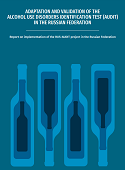THE RUS-AUDIT PROJECT REPORT: Adapting and validating the Alcohol Use Disorders Identification Test (AUDIT) in the Russian Federation (2021)

Download
2021; viii + 47 pages
ISBN: 978 92 890 5576 5
This publication is only available online.
The RUS-AUDIT is the Russian version of the Alcohol Use Disorders Identification Test (AUDIT), which was translated and adapted in line with existing WHO guidelines for translation and adaptation of instruments and subsequently validated for use in the Russian Federation. The validation study was carried out in a sample of over 2000 individuals from primary health-care (PHC) institutions in nine regions of the Russian Federation between August 2019 and February 2020.
The RUS-AUDIT demonstrated good psychometric properties and is recommended as a reliable and valid screening instrument for hazardous and harmful use of alcohol in the Russian Federation and, potentially, in other countries with similar alcohol consumption patterns. Availability of this adapted and validated instrument opens up opportunities for implementation of screening and brief interventions (SBIs) for alcohol in PHC settings in the Russian Federation and beyond.
The present report describes the project implementation of the RUS-AUDIT validation study, its main outcomes, and the specific challenges and lessons learned during the large interregional study. It describes the statistical procedures performed to determine optimal cutoffs for the RUS-AUDIT and the construction and determination of cutoffs for its short version, the RUS-AUDIT-S, which consists of only three items and can be used within the limited time constraints typical of PHC settings. The highlighted distribution of patients that were screened with the RUS-AUDIT as part of the study suggests that the anticipated workload for PHC services would be reasonable and manageable should the health system implement this newly validated test as part of routine SBI procedures for alcohol.
The report therefore concludes with the proposal of a first RUS-AUDIT application algorithm for implementation in PHC settings; it may also help in planning the further steps needed to set up a system incorporating a continuum of care between PHC and specialized treatment settings.



